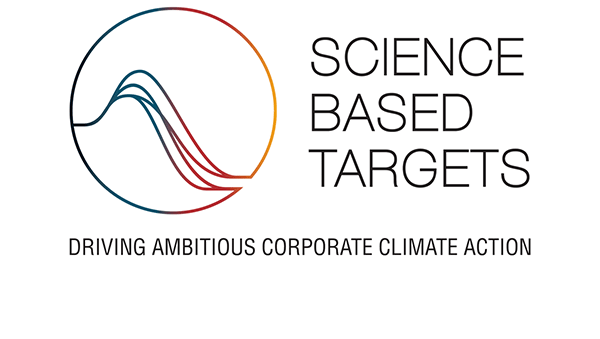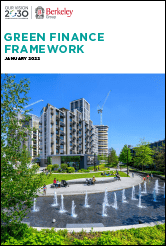
Climate Action
Our goal is to play an active role in tackling the global climate emergency by creating low carbon, resilient homes.
Our Approach
Berkeley is playing a lead role in tackling climate change. We have an ambitious, holistic approach for climate action, which includes designing efficient and resilient places, alongside transformational changes to our construction processes and wider business operations. We set stretching science-based targets in 2020 that push us to reduce our direct emissions, the embodied carbon in our supply chain, and the in-use emissions created by our homes. We are committed to supporting public policy and regulation in line with the goals of the Paris Agreement. We engage with key stakeholders, such as government and others across the built environment, to actively collaborate and help ensure that we are aligned with global goals, putting us on the pathway to be a net zero carbon business by 2045.
Ambitious Science Based Targets
Taking action to reduce our impact
In December 2020, the Berkeley Group set out our first science-based targets (SBTs) to reduce greenhouse gas (GHG) emissions, which were approved by the Science Based Targets initiative (SBTi). In summer 2025, we received validation from the SBTi for revised SBTs committing us to:
- Net-zero greenhouse gas emissions across the value chain by FY2045
- Near-term targets:
o Reduce absolute scopes 1 and 2 GHG emissions 86% by FY2034 from a FY2019 base year.
o Reduce absolute scope 3 GHG emissions 63% by FY2034 from a FY2019 base year.
o Install no new fossil fuel equipment that are owned or financially controlled by the company in its buildings portfolio from 1 May 2030. - Long-term targets:
o Reduce absolute scopes 1 and 2 GHG emissions 90% by FY2045 from a FY2019 base year.
o Reduce absolute scope 3 GHG emissions 90% by FY2045 from a FY2019 base year.
These targets were calculated to ensure that we play our part in limiting global warming to 1.5°C above pre-industrial levels and represent an ambitious step forward in Berkeley's approach to tackling climate change.
We publicly report our emissions and progress against our SBTs on an annual basis as detailed on our ESG performance page here.
Our emissions reporting methodology and details of the independent limited assurance received can be found within our carbon and climate change disclosures here.

Transition Plan
Working to become net zero carbon across scopes 1, 2 and 3 by 2045
Responding to the key areas of transitional risk and opportunities for the business, and to achieve our net zero ambitions, our transition plan focuses on reducing embodied carbon, low carbon operations and delivering low carbon homes (as detailed below). Key climate actions of our transition plan are detailed in our 2025 Annual Report.
As part of the development of our transition plan, Berkeley has been reviewing our future approach to carbon credits. We currently support the UK-based Retrofit Credits project developed by HACT and PNZ Carbon. This pioneering and unique project uses funds to retrofit social housing through the installation of energy efficient measures such as improved insulation, thereby reducing emissions of existing housing stock whilst also delivering social value.

Embodied Carbon
Meeting our science-based target by reducing the carbon impact of the materials and services we use
We recognise that the majority of our carbon impact comes from the materials and services we use to construct homes. We have undertaken more than 60 embodied carbon assessments across a range of building typologies, giving us valuable data to understand how our current buildings are performing and the biggest impact areas within our buildings so that we can reduce these during the design and procurement phases.
We have been working with our supply chain over several years to understand and reduce the carbon content of the materials and services we procure. We have implemented a supply chain engagement strategy for high carbon impact material groups and are delighted to have been listed as a CDP Supplier Engagement Leader in both 2023 and 2024. We preferentially partner with suppliers that share our commitment to climate action and are reducing emissions within their own operations.
This year the pilot version of the UK Net Zero Carbon Building Standard was released; we have chosen to align our internal targets with these industry-wide limits and to adopt the updated methodology for calculating embodied carbon set out by the Royal Institution of Chartered Surveyors (RICS) to ensure comparability in results. We also play an active role within several industry groups to share knowledge and lessons learnt. This includes the UK Green Building Council (UKGBC) and the Future Homes Hub.

Low Carbon Operations
Meeting our science-based target by reducing absolute emissions across our direct operations
We were proud to have achieved our initial scopes 1 and 2 SBT seven years early, through significant efforts and determination of our teams to operate more efficiently. This reduction was predominantly achieved through the use of certified biodiesel HVO (Hydrotreated Vegetable Oil) as a low carbon alternative to fossil diesel, which we continue to specify for direct fuel purchases. We allocate individual energy budgets to construction sites to focus attention on reductions and encourage our site teams to opt for electric and hybrid machinery.
We are also working to decarbonise our company vehicle fleet with new or replaced vehicles to be hybrid or electric from 2026.

Low Carbon Homes
Meeting our science-based target by reducing the in-use carbon emissions of our homes
We are striving to achieve our validated SBT to reduce the in-use lifetime carbon emissions of our homes. We focus on improving the fabric efficiency of our homes and integrating the appropriate low carbon technologies, including heat pumps and photovoltaic (PV) panels.
Our customer service and sales teams are provided with training to understand the sustainability features of developments and homes, and they provide a demonstration of these at handover, to enable and advocate low carbon lifestyles.
We have a requirement for all homes to achieve an Energy Performance Certificate (EPC) minimum energy efficiency standard rating of B, excluding refurbishments. This aligns with our Green Finance Framework.

Resilience
Managing climate risks for our developments and business
We are making our homes and places resilient to the impact of climate change. Prior to land purchase, we assess the land to identify all types of risks, including those related to climate change such as flooding and overheating. We will continue to incorporate adaptation measures in the homes and developments we build, and integrate nature-based solutions to create places that are more resilient to extreme weather.
We use the results of climate scenario analysis within our strategic planning processes to assess the risks and opportunities to our business posed by climate change.

2024/25 Highlights

77% reduction in absolute scopes 1 and 2 emissions since 2019

87% of operational energy consumption is from renewable sources, including 100% renewable electricity for UK activities

95% of completed homes achieved an EPC rating of B or above
Awards, Accreditations & Partnerships

Europe’s Climate Leaders 2025 – Listed Company
Financial Times

Supplier Engagement A List Leader
CDP

Validated Company Targets
Science Based Targets initiative (SBTi)


